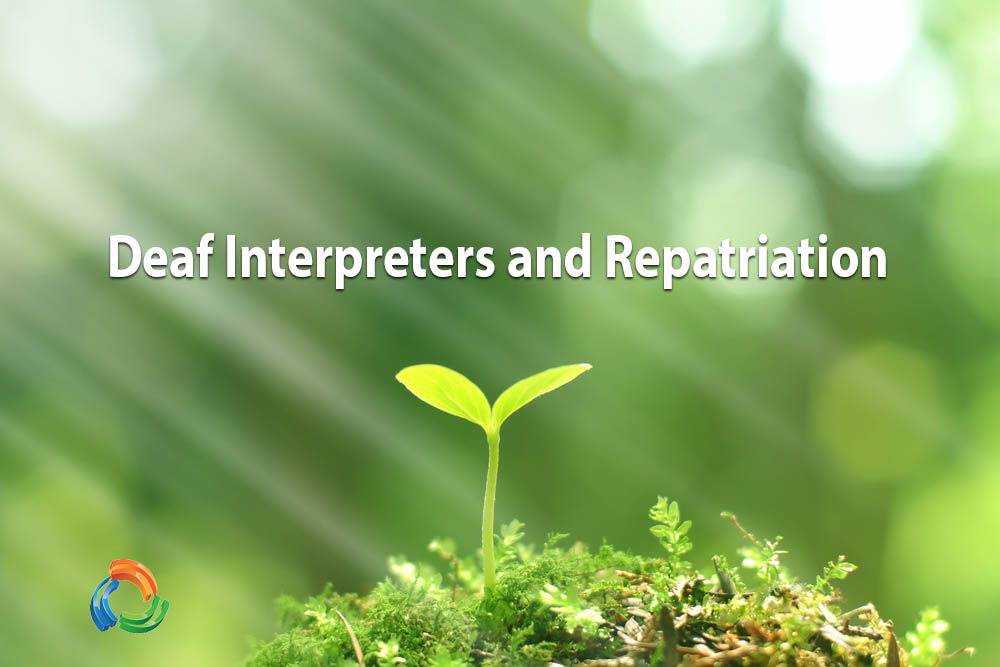
This is a cri de coeur that in our headlong rush to commoditization, we not forget our community roots.
For what does it profit a man to gain the whole world, and forfeit his soul? Mark 8:36
Not long ago, Sign Language interpreting was snug in the hands of deaf communities. Deaf people exerted great influence over the field, as practitioners and as leaders. There was little question then of where interpreting belonged or to whom the benefits of interpreting should accrue. The events of the past 50 years have changed much of this. The re-emergence of Deaf interpreters is hailed as a lifeline to our original purpose as interpreters.
Remembering the Past
Until October 10, 1973, I lurked in the shadows of Deaf World. On that day some of us were hanging around a television. We were actors in a touring theater company, and Harry Reasoner and ABC News were telling us that Vice President Spiro Agnew Had Just Resigned! At least they were telling those who could hear. Some of us who couldn’t hear, were rather too quick, I thought, to demand that I make known physically what Harry Reasoner and ABC News were going on about.
At this point I was nine weeks into Deaf World. I soon discovered some things from my old world that were no longer available; things like literacy and sense of humor in particular. In Deaf World my main schtick of being verbal was less useful, most of the time, than the ability to be funny, smart and/or skilled in physical ways.
But I was an actor, and I had seen interpreters work. I knew I could play the role of interpreter, if not do the job of interpreting. I remember fondly the encouragement from some of my audience, who assured me that my performance was certain to improve with practice and experience.
This was the way it had ever been. Interpreters were forged in the crucible of Deaf communities. Deaf people actively participated in the selection of who would interpret for them and when, and often, how. Deaf people in positions of authority in interpreting were the norm. The adolescent RID from Maryland, USA still lived in its parents’ basement on Thayer Avenue.
But adolescents grow up and grow away. RID moved into its own place and before you know it, here it is 2015, and CDIs are a welcome and growing presence. Of course, deaf people have been involved in interpreting for deaf people ab ovo. Shared access to information is woven into the culture. The RSCs of yesteryear are today rack focused as CDIs.
From Community to Curriculum
For 40 years, interpreting education has wandered the scholastic wilderness: finding prosperity in some few hospitable locations, but barely subsisting in many others. IEPs are often ‘orphan’ programs in their institutions. Sometimes housed in Language departments, but sometimes in Communicative Disorders. Sometimes yoked to vocational programs like air conditioning repair and auto mechanics. The relatively small number of students enrolled makes it difficult for many programs to secure adequate funding from their schools.
There has long been a desire to move interpreting education back, closer to its community roots. Deaf interpreters are an assurance that deaf people will remain strongly represented in and by our field going forward. Both community and interpreting have moved significantly in the last 50 years. Here is a rare opportunity to bridge that gap. By making deaf interpreters stakeholders in our educational programs and in our practice, we are respecting the past and protecting the future.
But why is it so much easier to champion this cause than to accomplish it?
From Curriculum to Commodity
The curricular impact of including deaf students into interpreting education programs is enormous. The inclusion of deaf students into IEPs demands the re-examination and revision of the entire curriculum in terms of standards, equity, and outcomes. This inclusion can have many wonderful benefits, but benefits that might come at significant cost. The plight of plugging deaf students into existing curricular structures designed for hearing students is considerable. The simple solution of offering instruction exclusively in ASL grossly oversimplifies the problem. Students who cannot yet express themselves adequately in their L1 are not advantaged by being forced prematurely into an L2-only mode. It also disregards the needs of those deaf students whose English fluency wants improvement. MJ Bienvenu does well in reminding us of the importance of interpreters being bilingual.
Similar challenges exist in melding deaf interpreters into existing workforces. Fundamental aspects of team interpreting with deaf interpreters are little understood, little explored. Roles, boundaries, responsibilities, and workloads vary widely, as do standards for education, training, and certification. Much work needs be done on creating norms for teams of deaf and hearing interpreters and for the inclusion of deaf interpreters into the practice of interpreting. NCIEC has done some early, brilliant work in this regard.
It is still early days in this most recent episode of the evolution of sign language interpreting and interpreting education. Those in positions of influence ought to explore deaf interpreting and to do whatever possible to support its natural growth and development. This is the best chance we’ve had in a very long time to bring our practice into balance with our original purpose.
But how do we best support this? Blanket provision of DIs in the absence of demonstrated need simply will not fly in most places. Of all the changes wrought in interpreting over the past half-century, one of the most profound is commoditization. Today Interpreters are both cross-cultural mediators and variables in profit maximization formulae. Interpreting has become a highly competitive billion-dollar industry. Interpretation is a commodity that is readily available at a wide variety of price points. In this economic climate, it is critical to distinguish need from preference, and cost from value. Given our recent history, it is not hard to foresee the implementation of Deaf Interpreters being underbid by providers more dedicated to profit than to best practice.
Where Does Interpreting Belong?
Who is to say where interpreting belongs today? Both the defining of interpreters and the definition of interpreting have become quite elastic, allowing for new, remarkable perspectives on the provenance of our craft. Culture and Community have always held strong sway on interpreting. Now, Business clamors about having a proprietary interest as well. Whither interpreting?
The resurgence in Deaf Interpreters could not come at a more auspicious time.
Questions to consider:
- Regarding interpreting, how do community standards, academic standards, and professional standards align?
- How best to include deaf students in our IEPs and deaf interpreters into our practice
- How do we reconcile the new “commodity” value of interpreting with the old “community” value of interpreting?


